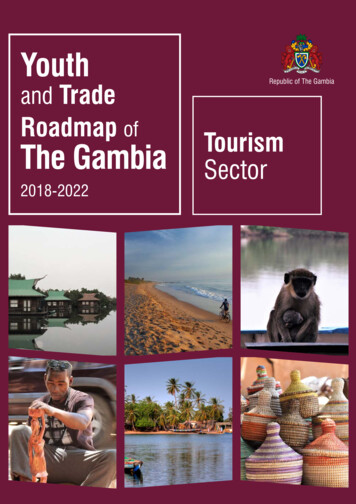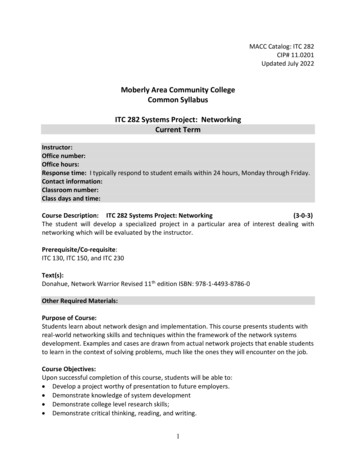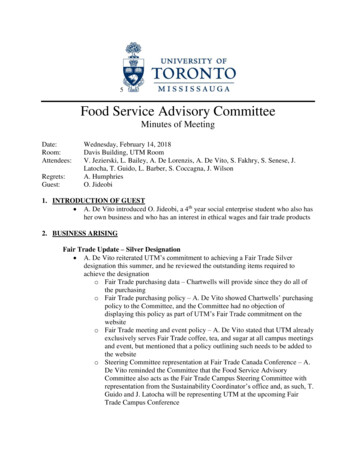
Transcription
Youthand TradeRoadmap ofThe Gambia2018-2022Republic of The GambiaTourismSector
YOUTH AND TRADE ROADMAP OF THE GAMBIATOURISM SECTOR2018-2022Republic of The Gambia
This Youth and Trade Roadmap for Tourism forms an integral part of The Gambia’sYouth and Trade Roadmap. It was developed under the aegis of the Republic ofThe Gambia and the Ministry of Trade, Industry, Regional Integration andEmployment ( MOTIE ). The strategy benefited from the contributions of sectorstakeholders and youth associations, who played an important role in the consultative process. This roadmap was designed with the technical assistance of theInternational Trade Centre ( ITC ) within the framework the Youth EmpowermentProject (YEP) and funded by the European Union Emergency Trust Fund for Africa.This document reflects the ambitions of the public and private stakeholders whodefined the enhancements and future orientations for the sector in view of developing economic opportunities for the youth in the tourism sector.Note to the reader about the Youth and Trade Roadmap:The Youth and Trade Roadmap for The Gambia sets out how to realize the full potential of trade for The Gambia’s youth. The document will serve as a guiding compassfor the government to bolster competitiveness and thereby reduce migration flows.The principal outputs of the Youth and Trade Roadmap for The Gambia designinitiative are four endorsed, coherent and comprehensive documents with five-yeardetailed plans of action ( PoA ) and implementation management framework. Thesedocuments include:1. The Youth and Trade Roadmap document, which identifies trade sectors’ growthpotential and economic opportunities for the youth. The roadmap defines in a comprehensive manner a prioritized development framework at the national level aroundfour pillars: skills development, entrepreneurship and self-employment, market-ledvalue chain development and sector coordination.2. Three individual sector roadmaps packaged as separate documents in line withthe main document’s overarching strategic objectives. The priority sectors offeringthe most promising potential for economic opportunities for the youth are: Nuts and agroprocessing Information and communications technology ( ICT ) Tourism.Sector roadmaps present action plans with activities and priorities for building market-oriented skills and fostering value addition that will create employment opportunities and income generation for the youth. Specifically, each sector roadmap providesrecommendations on improving productivity and quality, technical and vocationalskills, market reach and diversification, and how to facilitate youth entrepreneurship.
iiiThe Youth Empowerment Project aims to reduce migration pressures in The Gambia.The four-year project takes a market-led approach and sets out to strengthen existing youth development systems, structures and services to create employmentopportunities. It aims to scale up skills among youth in the workforce in response tomarket demands. The project offers possibilities for youths interested in moving intothe commercial agriculture, service business or tourism sectors.The EU Emergency Trust Fund for Africa addresses the root causes of irregularmigration and displaced persons in Africa. More specifically, it helps address the rootcauses of destabilization, forced displacement and irregular migration by promoting equal opportunities, and strengthening security, development and resilience ofvulnerable people.ITC is the joint agency of the World Trade Organization and the United Nations. ITChelps businesses in developing countries to become more competitive in globalmarkets, speeding economic development and contributing to the achievement ofthe United Nations Global Goals for sustainable development. As part of the ITCmandate of fostering sustainable development through increased trade opportunities, the Chief Economist and Export Strategy section offers a suite of trade-relatedstrategy solutions to maximize the development pay-offs from trade. ITC-facilitatedtrade development strategies and roadmaps are oriented to the trade objectivesof a country or region and can be tailored to high-level economic goals, specificdevelopment targets or particular sectors, allowing policymakers to choose theirpreferred level of engagement.The views expressed herein do not reflect the official opinion of ITC. Mention of firms,products and product brands does not imply the endorsement of ITC. International Trade Centre 2018ITC encourages reprints and translations for wider dissemination. Short extracts maybe freely reproduced, with due acknowledgement, using the suggested citation. Formore extensive reprints or translations, please contact ITC, using the online permission request form. quest/The International Trade Centre ( ITC )Street address:Postal address:Telephone:Email:Internet:ITC, 54-56, rue de Montbrillant, 1202 Geneva, SwitzerlandITC Palais des Nations 1211 Geneva, Switzerland 41- 22 730 0111itcreg@intracen.orghttp :// www.intracen.orgLayout:Jesús Alés – www.sputnix.es
ivACKNOWLEDGMENTSThe Youth and Trade Roadmap for Tourism was developed under the aegis of theMinistry of Trade, Industry, Regional Integration and Employment ( MOTIE ) and theMinistry of Youth and Sports ( MOYS ), with the financial support and technical assistance of the Youth Empowerment Project ( YEP ).The document particularly benefited from the inputs and guidance provided by themembers of the tourism core team that steered the formulation of the sector strategy,namely:NamePositionOrganizationMs. Kodou JabangPermanent SecretaryMinistry of Tourism & Culture( MOTC )Mr. Abdoulie HydaraDirector GeneralGambia Tourism Board ( GTB )Mr. Daouda NiangDirector GeneralGambia Tourism and HospitalityInstitute ( GTHI )Mr. Baba CeesayDirector GeneralNational Centre For Arts & Culture( NCAC )Mr. Sheikh T. NyangDirector GeneralInstitute of Travel and Tourismof The Gambia ( ITTOG )Ms. Marion NyanExecutive SecretaryGambia Hotel Association ( GHA )Mr. Momodou SeckaSecretaryAssociation of Small ScaleEnterprises in Responsible Tourism( ASSERT )Omar JammehYouth CoordinatorJust Act and Regional YouthCoordinator for Central River RegionMs. Oumie SiseAssistant ManagerDiscovery ToursMr. Lamin KintehManagerJaneya ToursMr. Adama BahIndependentThe Ninki Nanka Trail InitiativeMs. Anna SidibehManagerGambia River ExcursionsMs. Zainab JallowDirector GeneralFood Safety and Quality Authorityof The Gambia ( FSQA )
vSource: ITCTechnical support and guidance from the ITC was rendered through :NamePositionOrganizationMs. Marion JansenChief EconomistITCMr. Anton SaidHead of Trade StrategyProgrammeITCMr. Olivier MartyProject LeaderITCMr. Raimund MoserProject ManagerGambia YEP Youth EmpowermentProjectMs. Fatou JallowProject Coordinator and SeniorTechnical AdviserYouth Empowerment ProjectDr. Frederic ThomasInternational tourism consultantITCMr. Peter RichardsCultural tourism development andmarketing consultantITCMs. Potjana SuansriCommunity-based tourismconsultantITCMs. Alexandra GolovkoInternational consultantITCMs. Jasmeer VirdeeTrade SpecialistITCMs. Antonina PopovaTrade and Development AnalystITCAssisted by Ms. Amelia Diaz (intern)
Photo: (CC BY 2.0) tjabeljan @flickr
viiFOREWORDTOURISM CORE TEAM“A Great Opportunity for the Tourism Sector in The GambiaThe tourism core team of the Youth and Trade Roadmap is grateful to be part of thisgreat opportunity to connect youth with the goals of the tourism sector in developingan inclusive and sustainable tourism destination.The very essence of launching this roadmap as a team that includes stakeholdersfrom youth, public agencies, private businesses, training institutions and communities is a source of confidence and support for the future implementation of theroadmap.This Youth and Trade Roadmap for the tourism sector is part of The Gambia YouthEmpowerment Project (YEP), a four-year European Union-funded initiative to buildskills, enable value addition and foster market connections.Our goals and responsibilities to ensure that the interests of all our members arerepresented throughout the design and implementation of the roadmap is a greatopportunity for us to work together in creating sustainable tourism products throughinnovation, community-based development and youth empowerment.For this, the core team is committed to the successful implementation of the plan ofactions to carry the tourism sector forward sharing the Gambian culture, communities and landscape with the world while also contributing in providing a better futurefor our youth and turn our country into a beautiful place to live and visit.We would like to thank our partners, the International Trade Centre and the EuropeanUnion, for the support provided at this important time to help us create and seizethese opportunities for our young population.Sincerely,Adama BahOn behalf of the Tourism Core Team”
viiiCONTENTSAcknowledgments ivEXECUTIVE SUMMARY 1BACKGROUND 5TOURISM IN THE GAMBIA : A DEVELOPMENT PILLAR 7SECTOR PERFORMANCE 7VALUE CHAIN ANALYSIS 10BUSINESS ENVIRONMENT AND RELATED SUPPORT SERVICES 15Policy framework for tourism 15Business environment 16Sector support institutions 16KEY COMPETITIVE CONSTRAINTS IN THE TOURISM SECTOR 19Assessment of firm level capabilities using SME Competitiveness Survey results 20Assessment of the business ecosystem using SME Competitiveness Survey results 21SKILLS GAPS AND SKILLS DEVELOPMENT ISSUES 24Level of education in the tourism sector 24Skills gap analysis 25Most-needed occupations 26Types of training, internship and mentoring provided to overcome the current skills gap 27TVET mapping in the tourism sector 29From competitiveness issues to leveraging market opportunities for the youth 30THE WAY FORWARD : YOUTH EMPLOYMENT OPPORTUNITIES IN TOURISM 31THE VISION 31STRATEGIC OBJECTIVES FOR YOUTH EMPOWERMENT IN THE TOURISM SECTOR 31KEY SUCCESS FACTORS 33
ixMARKET TRENDS AND OPPORTUNITIES IN THE TOURISM SECTOR 33Keys market trends in The Gambia, European market and community-based tourism in Western Africa 33Demand for local experiences among tourists who are already visiting The Gambia 37Opportunities in alternative market segments and distribution channels 37Opportunities in alternative products : river cruises and the Ninki Nanka Trail 38Market strategy for key products, target market and market access partnerships 42YOUTH EMPLOYMENT OPPORTUNITIES IN THE TOURISM SECTOR Developing youth skills to improve and diversify tourism services and products LEVERAGING YOUTH EMPLOYMENT OPPORTUNITIES IN TOURISM 454646Leveraging opportunities in community-based tourism and ecotourism 46Leveraging the beach bar’s hospitality services 47Leveraging backward linkages with agropreneurs 47Leveraging opportunities in sport activities and events 48Leveraging ICT opportunities for youth in the tourism sector 48TVET STRENGTHENING AND ENTREPRENEUR SUPPORT PROGRAMME 49Update educational material and diversify training courses provided by existing TVET 49Develop support services for entrepreneurs 50Strengthen sector coordination to support youth in tourism 51STRATEGIC OBJECTIVES OF THE YOUTH AND TRADE ROADMAP FOR TOURISM 53PLAN OF ACTION 2018–2022 55ANNEXES 61
xFIGURESFigure 1: Tourism receipt and contribution to GDP and employment ( 2007–2015 ) 5Figure 2: Tourist arrivals by nationality – top 10 ( 2005–2016 ) 7Figure 3: Tourism development areas in The Gambia 8Figure 4: Graph depicting seasonality ( 2015–2016 ) 9Figure 5: Value chain mapping in the tourism sector 10Figure 6: ITC SME Competitiveness Survey 19Figure 7: Firm level capabilities assessment 20Figure 8: Business ecosystem assessment 21Figure 9: Level of education of employees in the sector 24Figure 10: Overview of barriers in employing young people by sector 25Figure 11: Preparedness of staff by level of education 25Figure 12: Level of competencies – tourism 26Figure 13: Most-needed occupations in tourism 26Figure 14: Types of training and mentoring that companies provide to their employees 27Figure 15: Enterprises’ facilitation of mentorship or internship 28Figure 16: TVET institutions – key facts for tourism 30Figure 17: Arrivals from traditional markets in 2015 and 2016 34Figure 18: Five innovations transforming the travel industry 35Figure 19: Romdeng social entreprise youth training restaurant, Phnom Penh, Cambodia 41Figure 20: Koto social enterprise youth training restaurant, Hanoi, Viet Nam 41Figure 21: Backward linkages possibilities in the tourism sector 45Figure 22: Backward linkages- possible intervention 48Figure 23: Entrepreneur and business growth concept for The Gambia 50Figure 24: Youth and Trade Roadmap implementation management framework 52Figure 25: Youth and Trade Roadmap sector core team 52
xiTABLESTable 1: Main TVET institutions in tourism 29Table 2: Key strategies for product-market matching and market access partnerships 44Table 3: Activities to strengthen training institutions 49BOXESBox 1: Ninki Nanka Trail itinerary upriver 39Box 2: Using the tourism social enterprise model to develop the Ninki Nanka Trail CTITCITTOGMOTCMOTIEAssociation of Arts & Crafts EntrepreneursAssociation of Small Scale Enterprises inResponsible TourismCommunity-based tourismFree independent travellersFajara Skills Development CentreFood Safety and Quality Authority of The GambiaGambia Hotel AssociationGambia Investment and Export Promotion AgencyGambia Tourism BoardGambia Tourism and Hospitality InstituteInformation and communications technologyInternational Trade CentreInstitute of Travel and Tourism of The GambiaMinistry of Tourism & CultureMinistry of Trade, Industry, Regional Integrationand AGTVETUNWTOWTOYEPMinistry of Youth and SportsMicro, small and medium-sized enterprisesNational Centre For Arts & CultureNon-governmental organizationPlan of actionSmall group adventureSmall and medium-sized enterprisesSME Competitiveness SurveyTourism Development AreaThe Gambia Standards BureauTourism and Travel Association of The GambiaTechnical and vocational education and trainingUnited Nations World Tourism OrganizationWorld Trade OrganizationYouth Empowerment Project
Photo: ITC
1EXECUTIVE SUMMARYThe Gambia’s tourism industry is a major economic driver and a priority sector of the new NationalDevelopment Plan to ensure positive spillover effects across the economy while enabling youthto contribute to the country’s economic development.The Gambia is mostly perceived as a seaside destination and has done well in developing the‘ The Smiling Coast of Africa ’. However, the richness of the natural and cultural assets found inThe Gambian countryside could quickly become an attractive destination with a greater andwidespread impact all across public and private interests. This could include the development ofa national tourism brand that can provide greater economic benefits beyond the coastal offeringswhile also improving the country’s social and economic development, particularly addressing thestrong cycle of migration and unemployment of the youth in the countryside.The ambition to disperse visitors across rural destinations faces special challenges. In particular,the environment of dependency on low-price-driven winter sun markets has created systemicobstacles to investing in and maintaining tourism facilities. This has contributed to low productinnovation, lack of skilled staff and low access to finance. These factors constrain the developmentof a prosperous and sustainable industry and reduce employment opportunities for youth in ruralareas. Therefore, there is a need to improve backward linkages with locally produced goods andcreate innovative tourism activities shaped with local communities, where places like the upperriver region can brand their tourism offerings to become part of a nationwide tourism experience.This approach will allow tourism to be handled in a more inclusive manner whereby it can trulyrealize the industry’s ability ensure economic progress and a sustainable contribution to povertyreduction and youth employment.With strong confidence in the untapped potentials of The Gambian tourism industry, this roadmapinitiative has helped mobilize the interests of the private and public actors to identify the bilateraleconomic opportunities found in developing a sustainable tourism industry that is capable ofempowering youth all across the country. In summary, this document aims to serve three purposes : firstly, present the status of the sector and its challenges ; secondly, inform stakeholdersof the existing potential to improve and develop new tourism services upriver ; and thirdly, providea realistic roadmap and a plan of action ( PoA ) geared at achieving the following overall vision :“Developing inclusive and sustainable tourism productsand services through youth empowerment.”[ EXECUTIVE SUMMARY ]
2To achieve this vision, the roadmap focuses on three strategic objectives.Strategic objective 1: Foster the creation of diversified tourism productsand servicesThe Gambia needs to develop new markets, products and distribution channels, which can diversify away from dependency on mass tour operators, enabling broader investments, maintenanceand innovation. The quality of tourist infrastructures and services, especially in the countryside,is below what international tourists, particularly international tour operators, can expect to visitor sell as a destination. The roadmap is geared at improving and diversifying community-basedand cultural tourism services up-country and developing new tourism services and products incoastal areas. Specifically, in terms of community-based tourism development, interventions willbe twofold : on one side, the roadmap aims to reinforce the existing community-based tourisminitiatives close to Banjul ; and simultaneously develop similar initiatives in new destinations upriver,especially in the Janjanbureh area. Backward linkages with agriculture, local craft and e-marketingservices will be developed, and forward linkages through new partnerships with outbound touroperators will take place in order to create new packages for their customers.Strategic objective 2: Reinforce youth skills through vocational trainingand TVET strengtheningThe upgrade of existing tourism services requires strengthening the skills across the sector andaddressing training institutions’ limited capacity. The challenge is to reduce the skills gap in thesector and improve the cooperation between the private sector and education providers to equipyoung people with the relevant skills needed in the market. This roadmap provides the foundationsto improve the quality and relevance of the skills development programmes offered by educationproviders in tourism. The plan focuses on the revision of existing curriculum, the development ofinternship and apprenticeships schemes and identification of priority actions to address the needsof the private sector for specific occupations. The two main training institutions will be supportedto upgrade their programme and build their capacities to deliver short-term courses to supportthe skills development plan of new tourism products upriver. The focus is to upskill youth involvedin hospitality services, tour guiding, management of community-based information services andcultural events through high-impact training programmes.Strategic objective 3: Develop and reinforce youth entrepreneurshipin the tourism sectorEntrepreneurship and innovation appears to be quite limited in vocational education programmes.Just as the roadmap aims to develop innovative tourism services and reduce the skills gap, itwill also supplement existing entrepreneurship and business growth support programmes withtechnical expertise in tourism and creative industries
Mr. Sheikh T. Nyang Director General Institute of Travel and Tourism of The Gambia (ITTOG) . Keys market trends in The Gambia, European market and community-based tourism in Western Africa 33 . Leveraging










